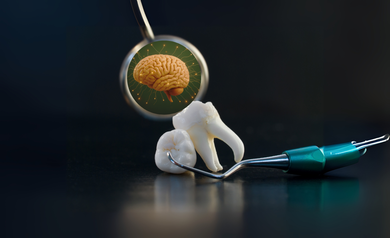- Health Conditions A-Z
- Health & Wellness
- Nutrition
- Fitness
- Health News
- Ayurveda
- Videos
- Medicine A-Z
- Parenting
- Web Stories
Alzheimer's Blood Test Results Show Shocking Results – How Accurate Is The Test?

Many people believe that being diagnosed with cognitive degenerative diseases like Alzheimer's is just about forgetting things. However, it is not that simple. The Alzheimer's diagnosis comes with not just lost memories, but also changes in the way you think, the way you behave as well as losing the memories and important factors of your life.
One of the most devastating facts about these cognitive diseases is the difficulty in diagnosing them early. There has been a lot of research done on how to identify early signs and symptoms of diseases like Alzheimer's; however, their accuracy is still under scrutiny.
A recent research showed that a simple blood test can accurately spot early signs of Alzheimer's disease. Experts have found that these blood tests can reliably find dementia by looking at two specific proteins in the blood.
New Blood Test for Alzheimer's
Scientists are excited about a new blood test that can really well find early signs of Alzheimer's disease. This test looks for two proteins, amyloid beta 42/40 and p-tau217. These proteins are linked to sticky clumps that build up in the brains of people with Alzheimer's. The test is very good at finding people with memory problems, with a 95% success rate. This means it hardly ever missed a case. It also correctly said that people did not have dementia 82% of the time. This amazing new test has even been approved by the Food and Drug Administration (FDA) in the US.
Why This Test Is Important
The number of people getting dementia is expected to go up a lot. Because of this, it's really important to find out if someone has it quickly and correctly. Scientists say this new blood test works just as well as the harder and more uncomfortable tests used now. It's also much easier and cheaper. Levels of the p-tau217 protein were much higher in people with Alzheimer's. Next, they will test it on even more people, including those who might have early Alzheimer's but don't show any memory problems yet.
Experts think this blood test will make finding Alzheimer's much faster, easier, and available to more people. While it mainly helps with Alzheimer's, the test was also used on people with other types of dementia. This suggests it could help figure out what's causing memory problems.
Pushing for Blood Tests in the NHS
There's a big project called the Blood Biomarker Challenge. It's supported by large charities and aims to bring blood tests for dementia diagnosis to the NHS by 2029. These tests are seen as super important for making diagnoses quicker. This will give more people faster access to the care, support, and treatments they really need. Investing in these new tests and the staff to use them is key, especially as new treatments for dementia are coming soon.
What's Next for Diagnosis
This new study adds to more and more proof that blood tests can find the diseases that cause dementia, even in people with early memory issues. But, we still need more research to see how well these blood tests work for everyone in everyday life. This is because people in studies might not always be exactly like all the people affected by dementia. Projects like the Blood Biomarker Challenge in the UK are working to gather this proof. This work will be a big step in making diagnosis easier and faster, helping us get closer to finding a cure.
BRCA Screening Before IVF: A Smart Safeguard or Ethical Overreach?

(Credit-Canva)
Recently, BRCA testing has garnered considerable attention, especially in the realm of reproductive medicine. BRCA1 and BRCA2 mutations are known to significantly increase the risk of breast and ovarian cancers. But as we begin considering their routine inclusion in IVF workups, we must ask: Are we proactively protecting future generations, or are we crossing into ethically uncertain territory?
In India, regulatory guidelines limit the number of donations from a donor to only a single recipient, placing significant constraints on donor selection. Moreover, potential genetic risks are already evaluated during donor screening through a detailed family and medical history. Sperm banks are careful to exclude donors with a known history of hereditary diseases that could impact the offspring. In addition, donors undergo stringent infectious disease screening, including sexually transmitted diseases like HIV, hepatitis B and C, and syphilis, to safeguard recipient health. These processes significantly mitigate both genetic and health-related risks.
This is not to undermine the value of BRCA or other genetic testing when clinically indicated. BRCA testing should be offered in IVF when there is a relevant personal or family history of cancers or where BRCA genes have been detected in the family. Couples who have experienced repeated miscarriages or have had a previous pregnancy loss where a genetic abnormality was found may benefit from more comprehensive genetic testing.
For women above the age of 35, another layer of screening becomes important: preimplantation genetic testing for aneuploidy (PGT-A). This is not about hereditary mutations but chromosomal abnormalities, which are more common as maternal age advances and lead to conditions like Down’s Syndrome in the child or recurrent miscarriages and IVF failures. PGT-A screens the embryos ensure that only chromosomally normal embryos are transferred into the uterus thus improving IVF success rates in older women.
Genetic screening plays a valuable role in safeguarding the health of future generations, but its use must be balanced with clinical relevance and ethical responsibility. The patients need extensive counselling on the procedure as it is invasive testing where afew cells are removed from the embryo and tested. In a small percentage because of mosaicism in embryo, there are also false positive reports (where abnormality is detected when none exists) and false negative reports (where abnormality exists but the report states a normal embryo). Patients must also be made aware of alternative methods of testing the child during pregnancy like NIPT (non invasive prenatal testing) and level 2 ultrasound during pregnancy to help them to take an informed decision.
However, incorporating BRCA testing or any advanced genetic screening into the routine workup for all IVF patients can significantly increase the financial burden of an already expensive procedure. While such tests are undoubtedly important in certain high-risk cases, they should be recommended judiciously, based on personal or family history, recurrent pregnancy loss or IVF failures, or previously identified genetic abnormalities. A targeted, case-by-case approach remains the most ethical and effective path forward in reproductive care.
Diagnostic Anomaly: This Man’s Brain Began Bleeding After A Regular Dental Checkup

Credits: Canva
'Diagnostic Anomaly' is a Health And Me Series, where we dive deep into some of the rarest of rare diseases. Here, we trace such diseases and what causes them. We also try to bring case studies around the same.
A routine dentist appointment turned into a medical emergency for a man in his late 60s living in Australia. Just 30 minutes after having two teeth extracted, he began experiencing sudden and alarming symptoms — dizziness, vomiting, and a bizarre distortion in his vision, where the world appeared rotated 90 degrees counterclockwise.
These were not trivial side effects of anesthesia or stress. The symptoms were pointing to something much worse. When he came to the emergency room, physicians observed strange signs: abnormal eye movement to the left and a tendency to fall to the right when walking. A brain scan validated their suspicion he was having an intracerebral hemorrhage (ICH), a potentially fatal form of stroke due to bleeding in the brain.
Intracerebral hemorrhage constitutes 10–15% of all strokes and entails a ruptured vessel bleeding into the brain tissue. Ischemic strokes caused by obstructions do not need such immediate intervention, while ICH needs to be urgently treated to stop bleeding, reduce brain pressure, and avoid irreversible neurological injury.
In this patient, the bleeding was in the lower-left side of his brain — a region that affects balance, coordination, and vision. His health care team reacted quickly to treat the hemorrhage, decrease his blood pressure, and relieve intracranial pressure. Thankfully, after receiving immediate treatment, he was stabilized and released with medication to regulate his blood pressure.
Three months after that, he made a dramatic recovery. His eyesight was back to normal, and his balance also considerably improved. To prevent future strokes over the long term, he was put on aspirin, which prevents narrowing of the blood vessels in the brain by keeping the blood thin.
Although clinically managing the case was according to typical stroke procedure, what makes this case uncommon is the suspected etiology: a simple dental treatment.
The man’s symptoms began just half an hour after his tooth extraction. Medical literature contains a few rare reports of individuals experiencing ICH following dental procedures, possibly due to sharp spikes in blood pressure triggered by pain, anxiety, or physiological stress. In this case, the working theory is that the dental procedure, coupled with an undiagnosed underlying condition, created the perfect storm for a stroke.
What Is White Matter Disease?
As the medical staff delved deeper into his background, they discovered further hints. Only six weeks earlier, the man had received neurological tests for potential Parkinson's disease. Scans at the time had already indicated signs of white matter disease — abnormalities in the network of wiring in the brain, which can cause thought to be slower, lead to loss of balance, and predispose to stroke and dementia.
White matter disease targets the brain's "communication highways," the nerve fibers (axons) that carry signals between different areas of the brain and spinal cord. The fibers need a continuous supply of oxygen and nutrients. When blood flow is slowed — because of age, high blood pressure, or damaged vessels — the white matter breaks down, creating lesions that are seen on MRI scans.
Symptoms of white matter disease may range from memory loss, difficulty with coordination, sluggish movement, mood changes, and even urinary incontinence. The symptoms are worse if the damage is more extensive.
But the story didn't end there. Genetic studies of the man revealed he had an uncommon mutation associated with CADASIL-Cerebral Autosomal Dominant Arteriopathy with Subcortical Infarcts and Leukoencephalopathy. This inherited disorder is found in approximately 2 in 100,000 and causes blood vessel walls to thicken. This compromise results in reduced flow of blood into the brain and a drastically increased risk of stroke.
Other research implies ICH can be an complication of CADASIL, particularly when added on top of other influences such as high blood pressure or physical stress.
The course of events now makes sense. The patient's existing white matter disease already compromising brain connectivity and his unknown CADASIL mutation had left his brain's blood vessels particularly susceptible.
The dental removal, though apparently innocuous, perhaps triggered an increase in blood pressure due to stress or pain, a normal physiological reaction in a medical context. For a person with healthy blood vessels, this may not have resulted in anything. But with a brain containing constricted, weakened vessels, the pressure was sufficient to rupture a vessel resulting in an intracerebral hemorrhage.
How Small Triggers Meet Big Risks
This case is an admonition regarding the intricate intersection of genetics, chronic illness, and acute medical stressors. It also highlights the need for recognition and control of risk factors such as hypertension, white matter disease, and unrecognized genetic disorders that affect brain function.
For individuals with cardiovascular risk factors — for example, diabetes, hypertension, or high cholesterol — regular procedures, including dental treatment, might necessitate closer follow-up. Preventive interventions, such as brain imaging in individuals with neurological symptoms and a history of stroke or dementia in first-degree relatives, might detect conditions such as CADASIL before complications arise.
Can White Matter Disease Be Prevented?
Although some white matter changes are inevitable with aging, progression can be slowed down. Good management of heart and vascular health is key. Here's what doctors say:
- Keep blood pressure under control
- Manage high cholesterol and diabetes
- Stop smoking
- Be physically active
- Eat a heart-healthy diet (such as the Mediterranean diet)
Studies have established that lowering cardiovascular risk has been proven to reduce white matter lesions, thus reducing stroke, dementia, and physical disability risks later in life.
A routine dentist visit triggered a series of events that almost resulted in a catastrophe for this Australian man but with timely rescue and extensive diagnostic procedures, not only did he recover well, but the doctors also discovered a rare genetic disorder that might have been a future threat.
Occasionally, the body's reaction to less invasive procedures can expose deep-rooted problems. Paying attention to your body, reporting new symptoms, and being proactive about brain and heart health can be the difference-maker — particularly when the indicators are easy to miss.
Pop Star Ella Henderson Talks About Her Painfully 'Devastating' Diagnosis After Years Of Struggle

Credits: Instagram/ellahendersonofficial
Pop star Ella Henderson’s voice has filled arenas across the UK and beyond, but her latest message isn’t a chart-topper—it’s a powerful, deeply personal disclosure that’s resonating with millions. In a recent Instagram video, the 29-year-old singer revealed she was diagnosed with endometriosis earlier this year, after struggling for years with intense stomach bloating, pelvic pain, and emotional distress.
What Henderson didn’t expect was how long and difficult her journey to a diagnosis would be—and how sharing it would help shine a spotlight on one of the most misunderstood chronic conditions affecting people assigned female at birth.
“For the last few years, it's been a bit of a rollercoaster, to say the least,” Henderson confessed in her video. While fans watched her perform and thrive in the spotlight, behind the scenes she was quietly battling unrelenting symptoms. She describes how she was plagued by stomach bloating, pelvic discomfort, and deep emotional turmoil—made worse by not being taken seriously.
“I thought at one point that this was just all in my head,” she said. “I wasn’t really believed.”
For many with endometriosis, that experience is painfully familiar.
After undergoing a laparoscopy—a minimally invasive surgical procedure used to diagnose and sometimes treat endometriosis—Henderson received confirmation that she wasn’t imagining anything. The procedure uncovered severe endometrial growths and scarring behind her uterus, affecting her bladder and bowel.
“Although the diagnosis was devastating, it was also validating,” she explained. “I could finally take control of my body.”
That moment of clarity often takes years for patients. According to Endometriosis UK, it takes an average of eight to nine years from symptom onset to diagnosis in the UK. Many people, like Henderson, suffer in silence, cycling through misdiagnoses while trying to manage what often becomes debilitating chronic pain.
What makes it harder is that some people have severe symptoms, while others may be asymptomatic. The severity of symptoms doesn't always align with the extent of the disease. Henderson spoke openly about how her physical struggles snowballed into mental health challenges. Living with constant pain, while being dismissed or misdiagnosed, took a toll.
“Not being believed led to periods of depression, isolation, and anxiety,” she said. “If health practitioners had recognised my symptoms sooner, all that might have been spared.”
This psychological burden is common among endometriosis patients. According to studies, mental health disorders, including anxiety and depression, occur at higher rates in those living with chronic pain from endometriosis. And yet, mental health support is rarely part of routine treatment plans.
Though there’s no cure for endometriosis, Henderson’s surgery helped ease her symptoms significantly. She’s now committed to long-term management, including lifestyle adjustments, possible hormonal therapy, and regular medical monitoring.
She’s also using her platform to advocate for awareness. In partnership with Endometriosis UK, Henderson is promoting tools to help others recognize symptoms early. One tool allows users to check symptoms in under a minute and generate a personalized letter for their healthcare provider—a small step that could dramatically shorten the diagnostic timeline for many.
Emma Cox, CEO of Endometriosis UK, praised Henderson’s courage in going public:
“Ella’s willingness to share her story will no doubt help others in their diagnosis journey,” she said. “Highlighting the significant and detrimental impact the condition can have on all aspects of someone’s life.”
And she’s right, endometriosis affects 1 in 10 women and people assigned female at birth—that’s over 1.5 million in the UK alone. Yet, stigma, misinformation, and delays in care are still the norm.
What is Endometriosis?
Endometriosis is a medical condition in which tissue that resembles the lining of the uterus grows outside the womb. These renegade cells are able to adhere to organs such as the ovaries, bladder, bowel, or even below the pelvis, responding to hormonal shifts similarly to uterine tissue—thickening, deteriorating, and bleeding with every menstrual cycle but unlike during a normal period, this tissue has no place to go, leading to inflammation, scarring, organ damage, and extreme discomfort.
Symptoms are diverse but frequently include:
- Heavy or painful periods
- Pelvic pain that is chronic
- Discomfort during intercourse
- Bowel and urinary discomfort
- Inability to conceive
- Severe bloating, also referred to as "endo belly"
- Excessive fatigue
Types of Endometriosis
There are four primary forms of endometriosis:
Peritoneal (superficial): On the thin layer of the pelvis.
Ovarian (endometriomas): Ovarian cysts packed with old blood.
Deep endometriosis: Deep tissue like in the bowel or bladder.
Extra-pelvic endometriosis: Uncommon instances where lesions occur in the lungs or surgical incisions.
Associated conditions such as adenomyosis, in which endometrial tissue invades the uterine wall, tend to exist concurrently with endometriosis, further complicating diagnosis and treatment.
While treatment involves hormonal therapies, analgesics, physical therapy, and surgery in some cases, there is no silver bullet, and most patients have to try a series of methods before experiencing relief.
And though Ella's celebrity generates publicity, the struggle for recognition, treatment, and compassion is that of every woman, girl, and individual touched by this frequently hidden disease.
If you or someone you know is experiencing symptoms of endometriosis, don’t wait. Speak with a healthcare professional and explore resources like Endometriosis UK or the Endometriosis Foundation of America because the sooner we stop doubting women’s pain, the sooner we start healing.
© 2024 Bennett, Coleman & Company Limited

